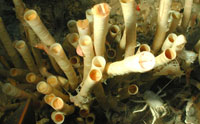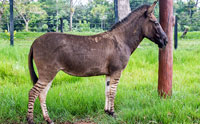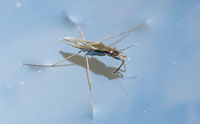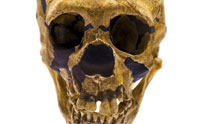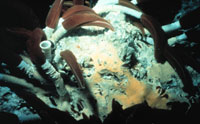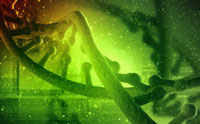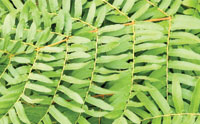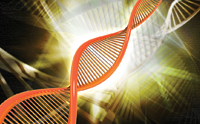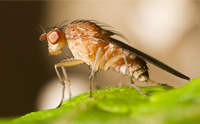This south American carnivore ignores meat-baited traps, but goes bananas over bananas! …read more Read more here: creation.com
Original soft tissue fossils are revolutionizing our understanding of how and when fossils formed. The science of tissue decay does not permit the conventional long ages assigned to them, yet even those ages pale in comparison with the “age” of recently described original, pliable, marine worm tissue in a Pre-Cambrian fossil said to be half a billion years old. More… …read more Read more here: icr.org Category: Creation Science Update
Zebra + Donkey = Zonkey. Zebras and donkeys actually have different numbers of chromosomes, making fertilization quite challenging, but cellular machinery sometimes somehow finds a way to form a viable offspring. More… …read more Read more here: icr.org Category: Creation Science Update
Modern ocean reefs can be quite massive, sometimes thousands of feet thick. How is it possible to get such thick reefs if they had only a few thousand years to grow? …read more Read more here: AIG Daily
The argument from ‘vestigial organs’ has been refuted many times by creationists, but some evolutionists still think it is a good argument against creation. Halldór M. from Iceland writes: Greetings, I was wondering if you could write an article that refuted this article here: [Web link removed as per our feedback rules—Ed.]. Not sure how scientific they are or if their information is accurate but it seemed like a very updated version of the vestigial argument for evolution. Kind regards, Halldór M. Iceland CMI’s Lita Cosner replies: Dear Halldór, I’ll take these ‘useless organs’ one at a time. Sometimes the [More]
Insects called water striders spend their lives gliding gracefully across stream surfaces. Scientists from China have uncovered some specific design specifications that perfectly suit the insects’ tiny leg hairs for walking on water. More… …read more Read more here: icr.org
Aided by his steady grip and excellent vision, the chameleon is always ready to seize unsuspecting prey. …read more Read more here: AIG Daily
Does our DNA point to alien creators? …read more Read more here: creation.com
Unsurprisingly, these skulls are not aliens, even though some people want you to think they are. …read more Read more here: creation.com
Famous for their dam-building, beavers have their own built-in ‘goggles’ to see clearly underwater. …read more Read more here: creation.com
Recent genome reports show that the Neandertals are essentially fully human, and the unique traits exhibited in their bones are related to epigenetics. More… …read more Read more here: icr.org
Why Homo habilis is not transitional between Homo erectus and australopithecines. …read more Read more here: creation.com
Why comic book fiction is not biological reality …read more Read more here: creation.com
Spectacular details in a special worm fossil contradict even the longest age estimates for genetic disintegration. This worm should have gone extinct a thousand times over, but apparently it didn’t die off even once. More… …read more Read more here: icr.org
Some of the primary candidates for being labeled “Junk DNA” have been the highly repetitive regions of the genome that, after years of study, seemed to have no discernable function. However, new research has shown that the RNAs encoded by these regions are key players in promoting genome stability and function. More… …read more Read more here: icr.org
Whether you love them or hate them (ugh, those molehills!), moles are testimony to a Creator. …read more Read more here: creation.com
As mere fragments, most fossils reveal only small hints of ancient life forms. But a fossilized fern’s stem recently discovered in Sweden shows its every detail, sending some clear messages about its origin. More… …read more Read more here: icr.org
Modern genomics provides the ability to screen the DNA of a wide variety of organisms to scrutinize broken metabolic pathways. This data has revealed wide-spread genetic entropy in human genomes. …read more Read more here: AIG Daily
Resistant rootworms can ravage corn if farmers put all their eggs in a genetically modified high-tech basket. …read more Read more here: AIG Daily
Its exotic plants actually show evolution has not happened …read more Read more here: creation.com
Scientists believe that the study of genes that encode the proteins for molecular motors will help solve the mysteries of evolution. However, the result of a recent study has only served to support the predictions of special creation. More… …read more Read more here: icr.org
From the landing stage, to the exit gate, it’s no accident that the travel corridor for a gnat visiting an orchid is strictly one-way. …read more Read more here: creation.com
The beautiful Barbary lion, now extinct, could be “re-built” and restored from its closest cousins. …read more Read more here: AIG Daily
Recent evidence of dual codes in the protein-coding sections of genes raised the bar on our understanding of genome complexity, and now a new study is showing that the control regions of genes contain dual codes as well. More… …read more Read more here: icr.org
The creature Pakicetus was initially regarded as a primitive whale, while further analysis confirms it was a land-dwelling mammal. …read more Read more here: AIG Daily
“Flower of the sea” is said to contain an evolutionary link between plants and animals. …read more Read more here: AIG Daily
Using new technology, researchers recently evaluated the diversity of gene expression across the fruit fly genome and discovered incredible complexity and design. More… …read more Read more here: icr.org

















![He’s Alive [Live] He’s Alive [Live]](http://img.youtube.com/vi/0gGa1w_bnvM/0.jpg)



